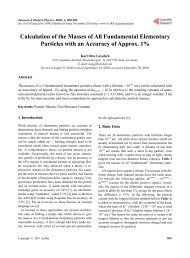Structure of the SAM-II riboswitch bound to S-adenosylmethionine
Structure of the SAM-II riboswitch bound to S-adenosylmethionine
Structure of the SAM-II riboswitch bound to S-adenosylmethionine
Create successful ePaper yourself
Turn your PDF publications into a flip-book with our unique Google optimized e-Paper software.
<strong>Structure</strong> <strong>of</strong> <strong>the</strong> <strong>SAM</strong>-<strong>II</strong> <strong>riboswitch</strong> <strong>bound</strong> <strong>to</strong> S-<strong>adenosylmethionine</strong><br />
Supplementary Information<br />
Sunny D. Gilbert 1 , Robert P. Rambo 2 , Daria Van Tyne 1 , and Robert T. Batey 1 *<br />
1 Department <strong>of</strong> Chemistry and Biochemistry, Campus Box 215, University <strong>of</strong><br />
Colorado, Boulder, CO 80309, USA; 2 Life Science Division, Lawrence Berkeley<br />
National Labora<strong>to</strong>ry, 1 Cyclotron Road, Bldg 6 Room 2105, Berkeley, CA 94720,<br />
USA<br />
*Author <strong>to</strong> whom correspondence should be addressed<br />
Telephone: (303) 735-2159<br />
Fax: (303) 492-5894<br />
E-mail: robert.batey@colorado.edu
Supplementary Figure 1 Secondary structure representation <strong>of</strong> wildtype and<br />
crystallized RNAs. (a) Sequence <strong>of</strong> <strong>the</strong> wild type RNA and also <strong>the</strong> RNA used in <strong>the</strong><br />
chemical probing experiments. A 21-nucleotide extension was added <strong>to</strong> <strong>the</strong> 3’end in<br />
order <strong>to</strong> ascertain <strong>the</strong> effect <strong>of</strong> this sequence on <strong>the</strong> unliganded RNA. Amino acids<br />
correspond <strong>to</strong> <strong>the</strong> first six residues <strong>of</strong> <strong>the</strong> putative metX gene, as identified by <strong>the</strong> high<br />
degree <strong>of</strong> homology <strong>to</strong> o<strong>the</strong>r identified metX genes. (b) Sequence and secondary<br />
structure <strong>of</strong> <strong>the</strong> crystallized <strong>SAM</strong>-binding mRNA psuedoknot upstream <strong>of</strong> <strong>the</strong><br />
putative metX gene from a Sargasso Sea metagenomic environmental sequence 1 . The<br />
nomenclature for <strong>the</strong> stems and loops (P1-P2 and L1-L3, respectively) is derived<br />
from standard naming <strong>of</strong> H-type pseudoknots. Red nucleotides are those whose<br />
identity is >95% conserved and blue corresponds <strong>to</strong> >80% conservation <strong>of</strong> identity.<br />
Starred residues indicate positions that were altered from <strong>the</strong> wild type sequence but<br />
retain <strong>the</strong>ir pattern <strong>of</strong> phylogenetic conservation (See Supplementary Table 1).<br />
Each change was made for a specific purpose: U1G for efficient transcription<br />
initiation by T7 polymerase, G52A for efficient 3’-end processing by a 3’-HδV<br />
ribozymes, and (C6G, U7C, A25G, G26U) <strong>to</strong> add a cesium/iridium ion binding site<br />
for phasing.
Supplementary Figure 2 <strong>SAM</strong> binding affinity <strong>of</strong> wild type (left) and crystallized<br />
(right) <strong>SAM</strong>-<strong>II</strong> RNA determined by Iso<strong>the</strong>rmal Titration Calorimetry (ITC).
Supplementary Figure 3 Electron density maps around <strong>the</strong> <strong>SAM</strong> binding site<br />
pro<strong>to</strong>mer A <strong>of</strong> <strong>the</strong> <strong>SAM</strong>-<strong>II</strong> <strong>riboswitch</strong> con<strong>to</strong>ured at 1σ (orange cage). The final<br />
model is superimposed upon <strong>the</strong> density (green, RNA; magenta, <strong>SAM</strong>). (a) Solvent<br />
flattened experimental electron density map. (b) Final 2Fo-Fc electron density map.<br />
(c, next page) Final 2Fo-Fc electron density map in wall-eyed stereo. Image is<br />
centered on <strong>the</strong> P1-P2b junction and shows <strong>the</strong> location <strong>of</strong> a cesium a<strong>to</strong>m (purple)<br />
<strong>bound</strong> <strong>to</strong> an engineered phasing module in <strong>the</strong> RNA.
Supplementary Figure 4 Superposition <strong>of</strong> <strong>the</strong> three pro<strong>to</strong>mers in <strong>the</strong> asymmetric<br />
unit that were built and refined individually. The standard pairwise r.m.s.d. for all<br />
a<strong>to</strong>ms in <strong>the</strong> RNA and <strong>SAM</strong> is 1.26 Å and <strong>the</strong> maximum likelihood r.m.s.d. for all<br />
a<strong>to</strong>ms is 0.19 Å, as calculated using <strong>the</strong> program THESEUS 20 . The two perspectives<br />
correspond <strong>to</strong> (a) Figure 1b and (b) Figure 1c (Figure 1b, c shows pro<strong>to</strong>mer A).<br />
Colors correspond <strong>to</strong>: red, molecule A; blue, molecule B; green, molecule C, as<br />
defined in <strong>the</strong> PDB coordinate file.
Supplementary Figure 5 Comparison <strong>of</strong> A-minor twist motifs in <strong>SAM</strong>-<strong>II</strong> <strong>riboswitch</strong><br />
(left) and glmS ribozymes (right) 18,19 . Watson-Crick paired helical regions are<br />
colored in blue. A-minor twist interaction is colored in magenta. The glmS model<br />
and numbering shown was created from <strong>the</strong> Glc6P-<strong>bound</strong> 2’-deoxy precleavage<br />
structure <strong>of</strong> <strong>the</strong> glmS ribozyme from T. tencongensis (PDB ID 2h0z) 19 .
Supplementary Figure 6 Raw data obtained from chemical probing experiments as<br />
well as stick representation <strong>of</strong> adenosine residue expected <strong>to</strong> be modified by DMS in<br />
<strong>the</strong> ligand <strong>bound</strong> structure. (a) Normalized and merged NMIA probing data. Peak<br />
height reflects <strong>the</strong> average percent reactivity <strong>of</strong> each residue over three experiments.<br />
The ligand-dependent changes in NMIA reactivity were calculated as <strong>the</strong> peak height<br />
difference between no <strong>SAM</strong> and 10 µM <strong>SAM</strong> (blue-red). Numbered residues are<br />
flipped out in <strong>the</strong> crystal structure and are expected <strong>to</strong> be increasingly modified by<br />
NMIA in <strong>the</strong> presence <strong>of</strong> <strong>SAM</strong>. (b) DMS reactivity <strong>of</strong> <strong>the</strong> <strong>SAM</strong> <strong>bound</strong> RNA. Blue<br />
bars represent <strong>to</strong>tal average radioactivity counts over three experiments at each<br />
adenosine position minus a (-) DMS reaction. (c) A49-G17 sheared base pair that<br />
exposes <strong>the</strong> Watson-Crick face <strong>of</strong> A49 in <strong>the</strong> ligand <strong>bound</strong> structure. (d) A41•A24-<br />
U40 base triple at <strong>the</strong> junction between <strong>the</strong> P1 and P2b helices. The Watson-Crick<br />
face <strong>of</strong> A41 is thrust in<strong>to</strong> solution upon ligand binding, a result <strong>of</strong> <strong>the</strong> coaxial stacking<br />
<strong>of</strong> <strong>the</strong> two helices as P2b becomes ordered. Arrows in (c) and (d) point <strong>to</strong> expected<br />
sites <strong>of</strong> DMS modification.
Supplementary Figure 7. Side-by-side comparisons <strong>of</strong> <strong>the</strong> pseudoknot from human<br />
telomerase RNA 21 (hTR, left) and <strong>SAM</strong>-<strong>II</strong>/<strong>SAM</strong> complex (right). The colors reflect<br />
<strong>the</strong> secondary structures <strong>of</strong> <strong>the</strong> RNA (blue, P1; green, P2; orange, L1; magenta, L3);<br />
<strong>the</strong> coloring pattern <strong>of</strong> <strong>SAM</strong>-<strong>II</strong> is slightly different from Figure 1 <strong>to</strong> make a clearer<br />
comparison between <strong>the</strong> two RNAs. The hTR structure shown is a model from <strong>the</strong><br />
family <strong>of</strong> structures derived from NMR constraints (PDB ID 1YMO).
Supplementary Table 1: Sequence alignment <strong>of</strong> <strong>SAM</strong>-<strong>II</strong> mRNAs tested for<br />
crystallizability.<br />
Consensus 1 •••GYG•Y•••GAUUU••••••••YY••RR•UUGCR•R•CRC••••AAA•AA••••GCUAAA•••••••RR<br />
Sequences with five base pairs in <strong>the</strong> P1:<br />
Env17 •••GCGCU•••GAUUU••••••••ACCUGAAUUGCG•AGCGCUUUAAAAAAACC••GCUAAAAAA••••GU<br />
Env15 •••GCGCU•••GAUUUGAG••••CUC•CAGCUUGCG•AGCGC•UAUAUAAAUACU•GCUAAA•••••••GAG<br />
Bth •••UGUGGACAGAUUU••••••GAGC••AGCUUGCAACCACG•••GAAAAAAAU••GCUAAAACA••••CGUC<br />
Env01 •••GCGCU•••GAUUU•••••AAACU••GAAUUGCG•AGCGC••UUAAAAAAACC•GCUAAACA•••••AGUUU<br />
Sequences with six base pairs in P1:<br />
Env12 ••CGCGCU•••GAUUUAA••••••CC••GUAUUGCA•AGCGCG•UGAUAAAUGUA•GCUAAAAA•••••GG<br />
Env12(eng) 2 ••CGCGGC•••GAUUUAA••••••CC••GUAUUGCA•GUCGCG•UGAUAAAUGUA•GCUAAAAA•••••GG<br />
Bja3 ••AGCGCC•••GAUUUGAUC•••CUC••AGCUUGCG•GGCGCU•UCUAAAAAUGCAGCUAAA•••••••GAG<br />
Mma2 ••CGUGGU•••GAUUUGUCC••GACC••GGAUUGCG•GCGACG•UUAAACAUCCC•GCUAAAGA•••••GGUC<br />
MetA ••AGUGGU•••GAUUUGC•••CGACC••GGCUUGCA•GCCACU•UUAAAGAAGUC•GCUAAAG••••••GGUCG<br />
Rpa2 ••CGUGGU•••GAUUUGAG•CCGCCC••GGCUUGCA•GCCACG•UUAAACAAGUC•GCUAAACA•••••GGGCGG<br />
Sequences with seven base pairs in P1:<br />
Env49 •AUGUCGU•••GAUUUAGA•••••CC••AAAUUGCC•GCGACGU•UAAACUAGAGUGCUAAAAA•••••GG<br />
Env03 •AUGUGGU•••GAUUUGAG•CCAGUC••GGCUUGCG•GCCACAU•AAAAGAAGUC•GCUAAAAAA••••GGCUGG<br />
Sequences with eight base pairs in P1:<br />
Env13 AUUGCGCC•••GAUUUGAGC••••AC••AGCUUGCG•GGCGCAAU•AAAAAUGCA•GCUAAAGAG••••GU<br />
Env24 UAAGUCGU•••GAUUUGG•••AUAGU••••AUUGCA•GCGACUUA•AAAUAAAUU•GCUAAAAUGGUAAAUUAU<br />
1 Consensus sequence <strong>of</strong> <strong>SAM</strong>-<strong>II</strong> mRNA based on 70 representative sequences 16 .<br />
Residues that are >95 % (red) and >80 % (blue) conserved are indicated (R=A,G;<br />
Y=C,U). Periods represent gaps in <strong>the</strong> alignment. Sequence labels correspond <strong>to</strong> <strong>the</strong><br />
source organism or environmental metagenome 17 in which <strong>the</strong> sequence was<br />
identified 1 . The P1 (shaded green) and P2a (shaded cyan) predicted base-pairing<br />
regions from <strong>the</strong> original alignments are shown for clarity 1 . A35 is colored red in all<br />
RNAs for reference.<br />
2 Sequence that was used in <strong>the</strong> final X-ray crystallographic construct.
METHODS<br />
RNA library syn<strong>the</strong>sis and purification. A series <strong>of</strong> RNAs corresponding <strong>to</strong><br />
secondary structure and sequence variations <strong>of</strong> <strong>the</strong> <strong>SAM</strong>-<strong>II</strong> RNA observed across<br />
phylogeny was constructed according <strong>to</strong> <strong>the</strong> length <strong>of</strong> <strong>the</strong> P1 and P2a helices <strong>of</strong> <strong>the</strong><br />
minimal <strong>riboswitch</strong> (Supplementary Fig. 1) 1 . These helices vary between 5-8 base<br />
pairs and 2-6 base pairs, respectively. Combinations <strong>of</strong> different helix length resulted<br />
in an initial library containing 13 representative RNAs that included <strong>the</strong> metA RNA<br />
previously characterized 1 . RNAs were constructed by standard PCR methods using<br />
overlapping DNA oligonucleotides (Integrated DNA Technologies) 2 . The resulting<br />
DNA fragment, that contained EcoRI and NcoI restriction sites at <strong>the</strong> 5’- and 3’- ends,<br />
respectively, as well as sequences coding for a T7 RNA polymerase promoter and an<br />
3’- HδV ribozyme was ligated in<strong>to</strong> pRAV12 3 . The resulting plasmid was verified by<br />
sequence analysis. Template DNA for in vitro transcription was generated by PCR<br />
from each individual plasmid using primers directed against <strong>the</strong> T7 RNA polymerase<br />
promoter at <strong>the</strong> 5’ end and <strong>the</strong> 3’ side HδV ribozyme (5’-<br />
GCGCGCGAATTCTAATACGACTCACTATAG; 3’-<br />
GCACAGTCTAGAGGTCCCATTCGCCATGCCGAAGCATGTTG). RNA was<br />
transcribed in a 12.5 mL reactions containing 40 mM Tris-HCl (pH 8.0), 10 mM<br />
DTT, 0.01 % Tri<strong>to</strong>n X-100, 2 mM spermidine-HCl, 6 mM <strong>of</strong> both ATP and GTP, 4<br />
mM <strong>of</strong> both UTP and CTP, 36 mM MgCl2, 25 mg/mL T7 RNA polymerase, 1 mL <strong>of</strong><br />
~0.5 µM template 3 , and 1 unit/mL inorganic pyrophosphatase. The reaction was<br />
incubated for 2 hours at 37 °C. RNA was precipitated in 70% EtOH, pelleted, and<br />
resuspended in load buffer containing 4 M urea, 100 mM Na-EDTA, pH 8.0, 25%
formamide, xylene cyanol, and bromophenol blue, and purified by denaturing 12%<br />
PAGE. Gel slices containing target RNA were excised from <strong>the</strong> gel, electroeluted in<br />
1x TBE buffer, collected, exchanged against 3 x 15 ml aliquots <strong>of</strong> buffer containing<br />
10 mM K + -HEPES, pH 7.5 using a 10,000 MWCO centrifugal filter device (Amicon,<br />
Ultra-15), and concentrated <strong>to</strong> ~500 µL. RNA concentrations were determined from<br />
<strong>the</strong> magnitude <strong>of</strong> <strong>the</strong> UV absorbance at 260 nm and <strong>the</strong> calculated extinction<br />
coefficient (703,040 M -1 cm -1 ) <strong>of</strong> <strong>the</strong> individual RNA’s base composition.<br />
RNA crystallization. <strong>SAM</strong>-<strong>II</strong> <strong>riboswitch</strong> crystals were obtained by <strong>the</strong> hanging<br />
drop/ vapor diffusion method in which <strong>the</strong> RNA solution was mixed in a 1:1 ratio<br />
with mo<strong>the</strong>r liquor. The initial library <strong>of</strong> RNAs was screened versus <strong>the</strong> PEG-Ion,<br />
Crystal Screen, Natrix, and Nucleic Acid Mini-screen (Hamp<strong>to</strong>n Research). RNAs<br />
and promising conditions were fur<strong>the</strong>r refined based on crystal morphology and size,<br />
as well as diffraction quality and space group. The final RNA construct was<br />
engineered <strong>to</strong> contain a heavy-ion binding phasing module in <strong>the</strong> P1 helix that did not<br />
alter any <strong>of</strong> <strong>the</strong> residues that are conserved across phylogeny (starred,<br />
Supplementary Fig. 1b) 4 . The final conditions that yielded diffractions quality<br />
crystals contained 8 mM cobalt hexammine chloride, 640 mM ammonium acetate,<br />
10% PEG 1K, 10 mM barium chloride, 50 mM Na + -cacodylate, pH 6.0, 25 °C.<br />
Single crystal growth required cat whisker micro-seeding from a solution containing<br />
microcrystals from previously grown, but polymorphic, <strong>SAM</strong>-<strong>II</strong> crystals suspended in<br />
mo<strong>the</strong>r liquor plus 8% (2R,3R)-butanediol. Crystals reached <strong>the</strong>ir maximum size<br />
(~200 x 200 x 200 µm, cube-like) in 3-5 days, and were subsequently backsoaked for
10-30 minutes in 30 µl <strong>of</strong> one <strong>of</strong> two heavy-a<strong>to</strong>m derivative solutions. Crystals<br />
designated for isomorphous replacement were backsoaked in mo<strong>the</strong>r liquor<br />
containing 2 mM magnesium chloride, 10 mM <strong>SAM</strong>, and 200 mM cesium chloride<br />
for ~10 minutes. Crystals designated as native were backsoaked for 10-30 minutes in<br />
mo<strong>the</strong>r liquor that only contained 320 mM ammonium acetate (all o<strong>the</strong>r components<br />
remaining <strong>the</strong> same) with <strong>the</strong> addition <strong>of</strong> 2 mM magnesium chloride, 10 mM <strong>SAM</strong>,<br />
and 600 mM lithium chloride also for ~10 minutes. This was followed by a 10-30<br />
minute exchange in<strong>to</strong> <strong>the</strong> same solutions containing <strong>the</strong> addition <strong>of</strong> 8 % (2R,3R)-<br />
butanediol. Crystals were looped and flash-frozen in liquid nitrogen. Diffraction data<br />
was collected on a home X-ray source (Rigaku MSC) using CuK α radiation.<br />
Anomalous diffraction data was collected by an inverse-beam experiment and was<br />
integrated, indexed, and scaled using HKL2000 5 .<br />
Phasing and structure determination. An initial heavy a<strong>to</strong>m solution was<br />
calculated using data from a single anomalous dispersion (SAD) experiment at CuK α<br />
with cesium as <strong>the</strong> anomalous scatterer. The solution containing four heavy a<strong>to</strong>ms<br />
(FOM = 0.27, Z-score = 17) was generated in SOLVE 6 . The heavy a<strong>to</strong>m solution<br />
was <strong>the</strong>n used <strong>to</strong> calculate experimental phases by single isomorphous replacement<br />
with anomalous scattering (SIRAS) experiment and diffraction data extending <strong>to</strong> 2.5<br />
Å resolution for <strong>the</strong> native data set and 2.8 Å resolution for <strong>the</strong> same cesium<br />
derivative set. Phases were calculated using CNS 7 in which a cesium was treated as<br />
<strong>the</strong> heavy a<strong>to</strong>m derivative, (f’ = -1.16, f” = 8.80), while a lithium back soaked crystal<br />
was treated as <strong>the</strong> native data set. Following density modification in CNS 7 , <strong>the</strong> figure
<strong>of</strong> merit improved <strong>to</strong> 0.35. An experimental electron density map was <strong>of</strong> sufficient<br />
quality <strong>to</strong> follow <strong>the</strong> trace <strong>of</strong> <strong>the</strong> phosphate backbone and identify regions <strong>of</strong> base-<br />
pairing for two <strong>of</strong> <strong>the</strong> three molecules in <strong>the</strong> asymmetric unit. Using model and<br />
experimental phases, a combined electron density map was calculated (FOM = 0.74)<br />
and <strong>the</strong> location <strong>of</strong> <strong>the</strong> third pro<strong>to</strong>mer was identified. All nucleotides in <strong>the</strong> three<br />
RNAs, as well as <strong>the</strong> locations <strong>of</strong> <strong>SAM</strong>, and three Cesium a<strong>to</strong>ms <strong>bound</strong> <strong>to</strong> <strong>the</strong><br />
engineered phasing module were eventually built through subsequent rounds <strong>of</strong><br />
iterative model building in PyMOL 8 and refinement in CNS 7 while following <strong>the</strong><br />
improvement <strong>of</strong> Rfree. Solvent molecules were added using two rounds <strong>of</strong> water-<br />
picking in CNS 7 . The 5’- and 3’- ends <strong>of</strong> <strong>the</strong> RNAs contained functional groups that<br />
required additional refinement at <strong>the</strong> end <strong>of</strong> <strong>the</strong> building process. The addition <strong>of</strong> a<br />
5’ppGTP and a 2’,3’-cyclic phosphate at <strong>the</strong> RNA termini were supported by <strong>the</strong><br />
electron density in <strong>the</strong>se regions. A Mg 2+ ion was also identified in <strong>the</strong> region where<br />
pro<strong>to</strong>mers A and B form a “head-<strong>to</strong>-head” stack causing <strong>the</strong> two 5’-diphosphate<br />
groups <strong>to</strong> come in<strong>to</strong> close proximity. The final R and Rfree are 20.6% and 26.3%,<br />
respectively. The refined model had a cross-validated Luzzati coordinate error <strong>of</strong><br />
0.50 Å.<br />
Chemical modification and structure probing. An RNA corresponding <strong>to</strong> <strong>the</strong><br />
<strong>SAM</strong>-<strong>II</strong> <strong>riboswitch</strong> found upstream <strong>of</strong> <strong>the</strong> putative metX gene from a Sargasso Sea<br />
metagenomic environmental sequence (COG2021; Accession number/position<br />
AACY0107673.1/130-200) 1 was constructed by standard PCR methods using<br />
overlapping nucleotides. In addition, <strong>the</strong> RNA contained 5’ and 3’ structure probing
cassettes that facilitate easy analysis <strong>of</strong> all <strong>the</strong> nucleotide positions 9 . The resulting<br />
PCR fragment was fur<strong>the</strong>r amplified using a 5’ primer containing a T7 promoter (5’-<br />
CTAATACGACTCACTATAGGCCTTCGGGCCAA) and a 3’ primer corresponding<br />
<strong>to</strong> <strong>the</strong> terminus <strong>of</strong> <strong>the</strong> 3’- structure cassette (3’-<br />
GAACCGGACCGAAGCCCGATTTGGATCCGGCGAACCGGATC). RNA was<br />
transcribed and purified as described above. The final concentration <strong>of</strong> <strong>the</strong> RNA was<br />
calculated from <strong>the</strong> UV absorption at 260 nM and an extinction coefficient <strong>of</strong><br />
1,316,100 M -1 cm -1 .<br />
Selective 2’-hydroxyl acylation analyzed by primer extension (SHAPE) using<br />
<strong>the</strong> chemical reagent N-methylisa<strong>to</strong>ic acid (NMIA) was performed essentially as<br />
previously described by <strong>the</strong> Weeks labora<strong>to</strong>ry 9 . Briefly, 2 pmols <strong>of</strong> <strong>SAM</strong>-<strong>II</strong> RNA in<br />
11 µl <strong>of</strong> 0.5x TE buffer was subjected <strong>to</strong> heat denaturation by incubating at 90 °C for<br />
3 minutes followed by refolding on ice for one minute at which point 1 µl <strong>of</strong> different<br />
concentrations <strong>of</strong> <strong>SAM</strong> (typically serial s<strong>to</strong>ck concentration dilutions <strong>of</strong> 200 µM, 100<br />
µM, 20 µM, and 10 µM) and 6 µl <strong>of</strong> folding buffer (333 mM K + -HEPES, pH 8.0, 20<br />
mM MgCl2, 333 mM NaCl) were added. Reactions were allowed <strong>to</strong> incubate on ice<br />
for a full 10 minutes. The final concentrations <strong>of</strong> <strong>SAM</strong> with respect <strong>to</strong> <strong>the</strong> RNA<br />
ranged from 20x <strong>to</strong> 1x while <strong>the</strong> final concentration <strong>of</strong> MgCl2 was 6 mM. Prior <strong>to</strong><br />
incubation with NMIA, RNA samples were separated in<strong>to</strong> two 9 µl reactions in thin-<br />
walled PCR tubes and allowed <strong>to</strong> equilibrate at 25 °C for five minutes. A 65 mM<br />
NMIA s<strong>to</strong>ck was prepared in anhydrous DMSO (Sigma) immediately prior <strong>to</strong> its<br />
addition <strong>to</strong> <strong>the</strong> reaction as a chemical probing reagent. NMIA was added in 1 µl<br />
amounts <strong>to</strong> each reaction, while <strong>the</strong> same amount <strong>of</strong> DMSO was added <strong>to</strong> each
negative control. Reactions were allowed <strong>to</strong> incubate for 125 minutes at 25 °C (five<br />
half-lives <strong>of</strong> <strong>the</strong> NMIA reagent in solution) before being s<strong>to</strong>red at -20 °C for up <strong>to</strong><br />
one week.<br />
Dimethyl sulphate (DMS) modification for probing <strong>the</strong> Watson-Crick faces <strong>of</strong><br />
adenosines was performed as previously described 10 . 10 pmols <strong>of</strong> renatured RNA<br />
prepared as described above was added <strong>to</strong> 200 µl <strong>to</strong>tal volume <strong>of</strong> DMS modification<br />
buffer (70 mM HEPES-KOH, pH 7.8, 10 mM MgCl2, 270 mM KCl) on ice.<br />
Reactions containing ligand had a final concentration <strong>of</strong> 100 µM <strong>SAM</strong>, while <strong>the</strong><br />
same volume <strong>of</strong> water was added <strong>to</strong> <strong>the</strong> unliganded reactions <strong>to</strong> maintain consistent<br />
salt concentrations. A 1:2 dilution <strong>of</strong> DMS (Sigma) in ethanol was added <strong>to</strong> each<br />
reaction in 2 µl amounts while <strong>the</strong> same volume <strong>of</strong> EtOH was added <strong>to</strong> negative<br />
controls. The reactions were incubated at 30 °C for 5 minutes, followed by <strong>the</strong><br />
immediate addition <strong>of</strong> 50 µl <strong>of</strong> DMS termination buffer (1 M Tris-acetate, pH 7.5, 1<br />
M β-mercap<strong>to</strong>ethanol, 1.5 M NaOAc, 0.1 mM EDTA) and 750 µl <strong>of</strong> ice cold EtOH.<br />
RNAs were precipitated by centrifugation in a microcentrifuge at 16,000xg for 30<br />
minutes at 4 °C and redissolved in 20 µl <strong>of</strong> 0.5x TE buffer. Reactions were s<strong>to</strong>red at -<br />
20 °C for up <strong>to</strong> one week.<br />
Following chemical modification, reverse transcription with a radiolabeled<br />
probe was preformed <strong>to</strong> analyze <strong>the</strong> extent <strong>of</strong> modification at each nucleotide. To 10<br />
µl <strong>of</strong> each reaction was added 2 µl <strong>of</strong> 32 P 5’-end labeled primer (~0.3 µM, 5’-<br />
GAACCGGACCGAAGCCCG) and incubated at 65 °C for five minutes <strong>to</strong> promote<br />
<strong>the</strong> melting <strong>of</strong> secondary structure. A second incubation at 35 °C for 5 minutes was<br />
sufficient for primer annealing. Following an initial one minute incubation at 52 °C,
6 µl <strong>of</strong> SHAPE enzyme mix (250 mM KCl, 167 mM Tris-HCl, pH 8.3, 16.7 mM<br />
DTT, 1.67 mM <strong>of</strong> each dNTP, and 0.33 units <strong>of</strong> Superscript <strong>II</strong>I Reverse Transcriptase<br />
(Invitrogen, Inc.)) was added and incubated at 52 °C for an additional five minutes.<br />
The reverse transcriptase reaction was s<strong>to</strong>pped by adding 1 µl <strong>of</strong> 4 M NaOH and<br />
transferring <strong>to</strong> a 90 °C sand bath for five minutes. Finally, <strong>the</strong> addition <strong>of</strong> 29 µl <strong>of</strong><br />
acid s<strong>to</strong>p mix (4:25 (v/v) mix <strong>of</strong> 1 M unbuffered Tris-HCl and s<strong>to</strong>p dye (85%<br />
Formamide, 0.5x TBE buffer, 50 mM EDTA, pH 8.0, with bromophenol blue and<br />
xylene cyanol added)). Samples were loaded on<strong>to</strong> a 12% denaturing PAGE gel and<br />
run for 5-6 hours at a constant 55 W. Gel images were obtained by scanning on a<br />
Typhoon phosphorimager (Molecular Dynamics).<br />
Band intensity was quantified using <strong>the</strong> SAFA program available from<br />
MatLab 11 . DMS data was averaged across three separate experiments run out on <strong>the</strong><br />
same gel. Band intensities from residues 50-53 corresponding <strong>to</strong> <strong>the</strong> series <strong>of</strong> four<br />
guanosines immediately 5’ <strong>to</strong> <strong>the</strong> AUG that were observed <strong>to</strong> be similarly modified in<br />
all reactions were used <strong>to</strong> normalize band intensities in each lane representing<br />
different reaction conditions. Data handling, calculation, and graphing were done in<br />
Micros<strong>of</strong>t Excel. All calculated and graphed data were subsequently correlated <strong>to</strong><br />
observations made on <strong>the</strong> original gel.<br />
NMIA data were also averaged across three experiments. Because no position<br />
in <strong>the</strong> RNA could be considered equally modified in all <strong>of</strong> <strong>the</strong> reaction conditions<br />
tested, and differences in loading, exposure time, and amount <strong>of</strong> radioactivity over<br />
multiple experiments run on multiple gels increased <strong>the</strong> variability in each<br />
measurement, we used a normalizing method based on <strong>the</strong> <strong>to</strong>tal radioactivity counts
per lane 12 . Normalizing <strong>to</strong> differences in <strong>the</strong> sum <strong>to</strong>tal <strong>of</strong> radioactivity counts per<br />
lane accounted for <strong>the</strong>se systematic errors. As a control, we observed that a<br />
significant percentage (>40%) <strong>of</strong> <strong>the</strong> nucleotides analyzed were largely unmodified<br />
by NMIA or unchanged by <strong>the</strong> presence <strong>of</strong> <strong>SAM</strong>. We were able <strong>to</strong> calculate a<br />
percentage reactivity for each band in each lane and compare <strong>the</strong> percent across<br />
multiple experiments, correlating this with our observations. Changes in reactivity<br />
upon <strong>SAM</strong> binding that were considered significant (greater in magnitude than <strong>the</strong><br />
dashed lines in Fig. 4a) are >0.5 change in percentage reactivity or
was dissolved fresh in water <strong>to</strong> a s<strong>to</strong>ck concentration <strong>of</strong> ~100 mM and <strong>the</strong>n readjusted<br />
in dialysis buffer <strong>to</strong> within 7-10x <strong>the</strong> concentration <strong>of</strong> RNA. Concentrations <strong>of</strong> <strong>SAM</strong><br />
(ε260 = 13,400 M -1 cm -1 ) and <strong>the</strong> RNA (ε260 = 703,040 M -1 cm -1 ) were determined by<br />
UV absorbance on a spectropho<strong>to</strong>meter. RNA concentrations were all ~ 15-20 µM.<br />
Samples were degassed for 10 minutes at 25 °C prior <strong>to</strong> titration experiments. ITC<br />
experiments were carried out at 30 °C, a reference power <strong>of</strong> 5 µcal sec -1 , an initial<br />
delay <strong>of</strong> 60 seconds, and titration <strong>of</strong> 32 ten µl injections at an injection rate <strong>of</strong> 0.5 µl<br />
sec -1 ; individual injections were spaced 210 seconds apart.<br />
Data from each experiment was fit <strong>to</strong> a single-site binding model using Origin<br />
ITC s<strong>of</strong>tware (Microcal S<strong>of</strong>tware, Inc). Values for <strong>the</strong> association constant Ka were<br />
extrapolated using <strong>the</strong> equation<br />
q = " •#H •[RNA]• Ka L<br />
n<br />
[ ] i<br />
n<br />
1+ Ka L<br />
$ Ka L<br />
%<br />
'<br />
'<br />
&<br />
1+ Ka L<br />
<strong>the</strong> volume<br />
!<br />
<strong>of</strong> <strong>the</strong> reaction, Li is <strong>the</strong> ligand concentration at <strong>the</strong> i th injection 15 . The<br />
[ ] i<br />
n<br />
[ ] i$1<br />
n<br />
[ ] i$1<br />
where q is <strong>the</strong> directly measured amount <strong>of</strong> heat released during each injection, v is<br />
disassociation constant, Kd (in µM) was calculated from <strong>the</strong> inverse <strong>of</strong> <strong>the</strong> Ka.<br />
(<br />
*<br />
*<br />
)
References.<br />
1. Corbino, K.A. et al. Evidence for a second class <strong>of</strong> S-<strong>adenosylmethionine</strong><br />
<strong>riboswitch</strong>es and o<strong>the</strong>r regula<strong>to</strong>ry RNA motifs in alpha-proteobacteria.<br />
Genome Biol 6, R70 (2005).<br />
2. Sambrook, J. & Russel, D.W. Molecular Cloning: A labora<strong>to</strong>ry manual, (Cold<br />
Spring Harbor Labora<strong>to</strong>ry Press, Cold Spring Harbor, New York, 2001).<br />
3. Kieft, J.S. & Batey, R.T. A general method for rapid and nondenaturing<br />
purification <strong>of</strong> RNAs. RNA 10, 988-995 (2004).<br />
4. Keel, A.Y., Rambo, R.P., Batey, R.T. & Kieft, J.S. A general strategy <strong>to</strong> solve<br />
<strong>the</strong> phase problem in RNA crystallography. <strong>Structure</strong> 15, 761-72 (2007).<br />
5. Otwinowski, Z. & Minor, D. Processing <strong>of</strong> x-ray diffraction data collected in<br />
oscillation mode. Methods in Enzymology 276, 307-326 (1997).<br />
6. Terwilliger, T. SOLVE and RESOLVE: au<strong>to</strong>mated structure solution, density<br />
modification and model building. J Synchrotron Radiat 11, 49-52 (2004).<br />
7. Brunger, A.T. et al. Crystallography & NMR system: A new s<strong>of</strong>tware suite for<br />
macromolecular structure determination. Acta Crystallogr D Biol Crystallogr<br />
54 (Pt 5), 905-21 (1998).<br />
8. DeLano, W.L. The PyMOL Molecular Graphics System. (2002).<br />
9. Wilkinson, K.A., Merino, E.J. & Weeks, K.M. Selective 2'-hydroxyl acylation<br />
analyzed by primer extension (SHAPE): quantitative RNA structure analysis<br />
at single nucleotide resolution. Nat Pro<strong>to</strong>c 1, 1610-6 (2006).<br />
10. Kjems, J., Egebjerg, J. & Christiansen, J. Analysis <strong>of</strong> RNA-protein complexes<br />
in vitro, (Elsevier, 1998).<br />
11. Das, R., Laederach, A., Pearlman, S.M., Herschlag, D. & Altman, R.B.<br />
SAFA: semi-au<strong>to</strong>mated footprinting analysis s<strong>of</strong>tware for high-throughput<br />
quantification <strong>of</strong> nucleic acid footprinting experiments. RNA 11, 344-54<br />
(2005).<br />
12. Kieft, J.S., Costantion, D.A., Filbin, M.E., Hammond, J. & Pfingsten, J.S.<br />
Structural methods for studying IRES finction, (Elsevier, 2007).<br />
13. Ryder, S.P. & Strobel, S.A. Nucleotide analog interference mapping. Methods<br />
18, 38-50 (1999).<br />
14. Vicens, Q., Gooding, A.R., Laederach, A. & Cech, T.R. Local RNA structural<br />
changes induced by crystallization are revealed by SHAPE. RNA 13, 536-48<br />
(2007).<br />
15. Wiseman, T., Willis<strong>to</strong>n, S., Brandts, J.F. & Lin, L.N. Rapid measurement <strong>of</strong><br />
binding constants and heats <strong>of</strong> binding using a new titration calorimeter. Anal<br />
Biochem 179, 131-7 (1989).<br />
16. Griffiths-Jones, S. et al. Rfam: annotating non-coding RNAs in complete<br />
genomes. Nucleic Acids Res 33, D121-4 (2005).<br />
17. Venter, J.C. et al. Environmental genome shotgun sequencing <strong>of</strong> <strong>the</strong> Sargasso<br />
Sea. Science 304, 66-74 (2004).<br />
18. Cochrane, J.C., Lipchock, S.V. & Strobel, S.A. Structural investigation <strong>of</strong> <strong>the</strong><br />
GlmS ribozyme <strong>bound</strong> <strong>to</strong> its catalytic c<strong>of</strong>ac<strong>to</strong>r. Chem Biol 14, 97-105 (2007).
19. Klein, D.J. & Ferre-D'Amare, A.R. Structural basis <strong>of</strong> glmS ribozyme<br />
activation by glucosamine-6-phosphate. Science 313, 1752-6 (2006).<br />
20. Theobald, D.L. & Wuttke, D.S. THESEUS: maximum likelihood<br />
superpositioning and analysis <strong>of</strong> macromolecular structures. Bioinformatics<br />
22, 2171-2 (2006).<br />
21. Theimer, C.A., Blois, C.A. & Feigon, J. <strong>Structure</strong> <strong>of</strong> <strong>the</strong> human telomerase<br />
RNA pseudoknot reveals conserved tertiary interactions essential for function.<br />
Mol Cell 17, 671-82 (2005).



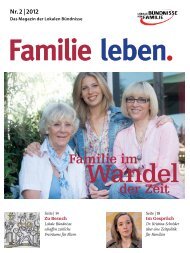
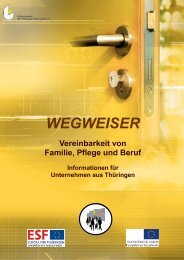
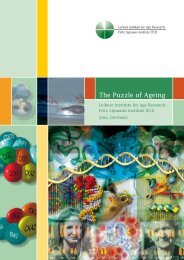

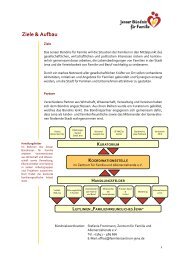



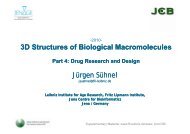
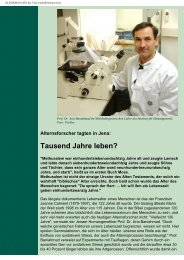

![Programm [pdf]](https://img.yumpu.com/20944039/1/184x260/programm-pdf.jpg?quality=85)
